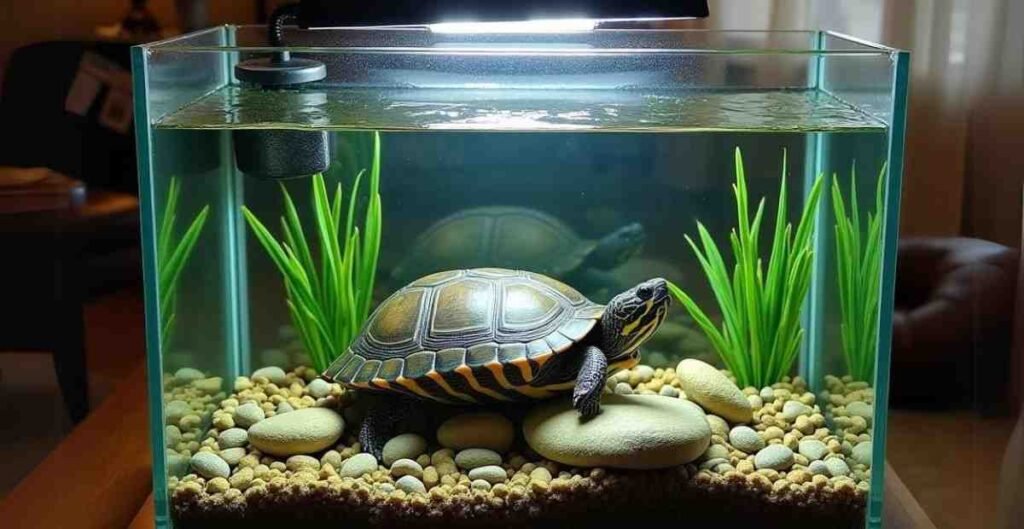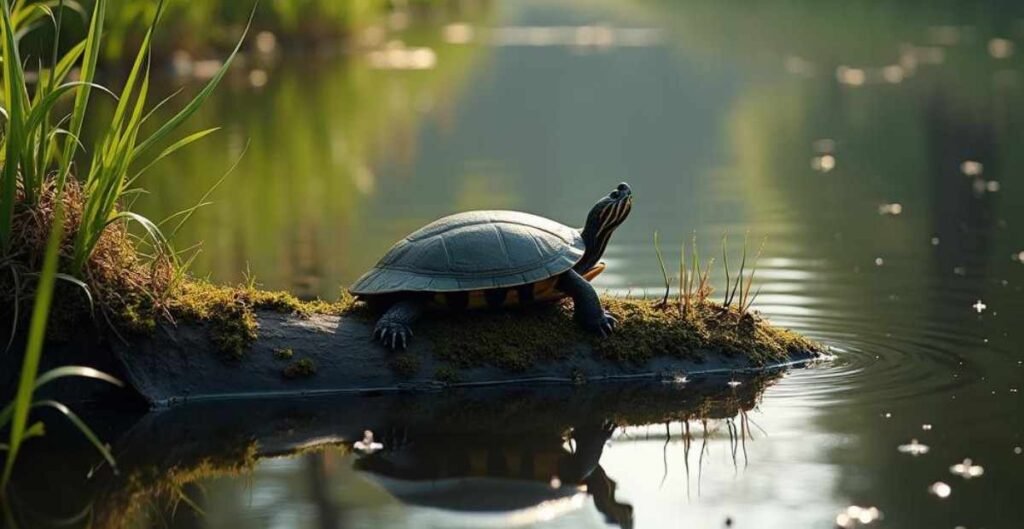If you are a turtle enthusiast and are curious about this question—”How long do pet turtles live?” It’s no wonder. Turtles or tortoises are fascinating reptiles, especially when we think about their lifespan. Some turtles can live several decades, and some tortoises’ lifespans can exceed centuries. The average lifespan of pet turtles, like the red-eared slider, can be 20-40 years, or for the leopard tortoise, it can be 100+ years.
There are a lot of factors that affect turtles’ life expectancy, including species, diet, and environment. If you take care of them, including providing a balanced diet and a nice habitat, they’ll live a lot longer. So, we will dive into this query of pet turtle owners: how long do pet turtles live?
Table of Contents
How Long Do Pet Turtles Live?

Pet turtles can live for a long time, depending on their species. For example, red-eared sliders, which are one of the most commonly owned types of pet turtles, typically live from 20 to 40 years. Furthermore, larger species, such as the leopard tortoise, can live longer than 100 years.
Generally, the general lifespan of pet turtles will be based on both species and other factors, such as diet and the environment under which a turtle is raised. You can add these gentle companions to your family for a long time with the right attention and care.
How Long Do Turtles Live For as Pets: Different Species Lifespan

Several species of turtles make good pets, and they vary in age and how long they age.
- Red-Eared Slider: It is one of the most popular pet turtles. This turtle species from America can live approximately 20-40 years. They can sometimes outlive these numbers if they’re handled with the proper care, especially in captivity.
- Painted Turtles: These turtles age range is about 20-30 years on average. Although some of them can live for over forty years. The painted turtle ages depend on feeding, state environment.
- Box Coin Turtle: Box turtle’s age can reach approximately 40-50 years due to their hardiness. In most cases, these turtles’ ages are dependent on the climate and the humidity. It means their lifespan depends on where they live and how they are taken care of.
- Map Turtle: A continental map turtle lives less than ten years but has an age range of 15-25 years. Their age depends on, for example, feeding and which food to avoid and clean water supply.
- Mud Turtle: Mud turtles usually can live up to 15-20 years old, which is a bit younger than map turtles. Their age depends much on how one keeps them, for example, proper feeding and temperature setup.
- Leopard Tortoise: These turtles have an age of over 100 years, which makes the turtles amongst the oldest or long-living pet turtles. The leopard tortoise’s lifespan depends on a lot of things like habitat. For example, you have to keep them in a suitable environment.
- Greek tortoises: These turtles can live over 100 years, depending on how they are kept. This makes them the oldest pet species of turtles, like leopard tortoises.
Different Species Pet Turtle Lifespan Chart
| Species | Average Lifespan (Years) | Habitat Preferences | Care Tips |
| Red-Eared Slider | 20-40 | Aquatic environments with basking areas | Provide a mix of aquatic plants and proteins |
| Painted Turtle | 20-30 | Freshwater habitats with soft bottoms | Maintain clean water and offer a varied diet |
| Box Turtle | 40-50 | Forested and humid areas | Ensure stable temperature and humidity |
| Map Turtle | 15-25 | Rivers and slow-moving waters | Balanced nutrition and clean water are crucial |
| Mud Turtle | 15-20 | Shallow, slow-moving water bodies | Hardy but needs regular habitat maintenance |
| Leopard Tortoise | 100+ | Arid and semi-arid regions | Large enclosures with plenty of sunlight |
| Greek Tortoise | 100+ | Mediterranean climates | Require well-drained, warm environments |
What Are The Factors Affecting Turtle Lifespan

The question of how long the turtles live depends mainly on their care. You need to know the reasons that influence the life span of turtles so you can make your turtle live longer.
Species-Specific Needs
Different turtles of different species have different lifespan periods. For example, while a red-eared slider may live only 20-40 years, an adult leopard tortoise can live more than 100 years. Banning your turtles means you need to know what their needs are to provide the necessary conditions for a long life.
Diet and Nutrition
A good or balanced meal is the key to turtle health and longevity. They contain proper nutrition. Aquatic turtles love both plant and animal matter. On the other hand, male desert tortoises prefer meals that include vegetables and plant-based food. Insufficient vitamin D3 and calcium can cause diseases and shorten turtles’ lives.
Genetics
Genetics also play a significant role in how long a turtle lives. You can control diet and habitat, but genetics determine how long the turtle will live anyway. Some turtle families have naturally longer lifespans. There may be a difference in how long similar turtles live under similar conditions.
Environmental Conditions
The turtles’ environment also influences the length of their life. Turtles need different right temperatures, light, and humidity setups. The central shape and humid weather can be maintained in a heated room by summer boxes. For example – it’s hard for box turtles to mimic their natural environment without a constant temperature and humidity. Improper conditions mean equilibrial stress and poor health.
How to Determine Your Turtle’s Age?
Your turtle’s care routine can be enhanced if you know its age. Here are some practical ways to figure out how old your turtle is.
Physical Indicators: Shell Size and Scute Rings
Examining the shell of a turtle is one of the most common ways to estimate its age. A shell’s size is a good way to estimate its age; however, the environment can affect growth. There is also a method that involves counting the rings on the scutes (the shell’s sections). Turtles generally produce one ring per growth season, which is one year. A better way to determine accuracy is to count rings on several scutes and calculate the average.
Behavioral Changes
Turtles’ behavior can change as they age. Turtles are a lot more active when they’re young, exploring their surroundings constantly. Their activity may stabilize as they mature, usually between 5 and 8 years old. You might see older turtles basking more and not exploring as much. These changes can give you clues about their maturity and, indirectly, their age.
Care Tips to Extend Your Turtle’s Lifespan

It’s important to take care of your turtle so it lives a long, healthy life. So, how long do tortoises live – the answer depends on several factors. Here are some tips to help you.
Proper Diet
The health of your turtle depends on a healthy diet. You should eat greens like kale and dandelion leaves, fruits like apples, and proteins like insects and small fish. Keeping them away from spinach and foods high in oxalic acid can harm their health and interfere with calcium absorption.
Habitat Maintenance
For your turtle’s well-being, you need a clean and spacious environment. Small turtles can live in 20-30 gallon enclosures, but larger turtles might need 60-120 gallon enclosures. To prevent diseases and keep the tank comfortable, you have to clean the pet turtle tank regularly and keep the water clean.
UVB Lighting and Temperature Control
It’s important to provide UVB lighting to make vitamin D3, which helps turtles absorb calcium and maintain bone health. You should ensure your turtle gets around 12 hours of light per day. The water temperature should also be maintained at an optimal level; aquatic turtles generally thrive at temperatures between 75 °F and 86 °F. Proper lighting and temperature can help boost your pet turtles’ immune systems.
Myths vs. Facts About Turtle Lifespan
With their ancient wisdom and longevity, turtles have fascinated us for a long time. However, myths often exaggerate how long they live. Let’s separate fact from fiction here.
Turtles Living for Centuries
There is a common myth that turtles live for hundreds of years and that they have lived on the Earth since ancient times. Indeed, turtles have long lifespans in comparison to many animals, but not all turtle species usually live for more than a century. Depending on how well a turtle lives, it may exist from 20 to 50 years. For example, it is known that box turtles could reach 50 and some more years, but it is far from a hundred.
Clarification on Documented Longest-Living Turtles
After all, it is not completely wrong to say that turtles have lived for centuries. The thing is that there is an exception. Jonathan from Seychelles is a giant tortoise and the world’s oldest living land animal. He became an example: Jonathan was 191 years old. But the truth is that it is a rare case.
FAQs
How long do box turtles live as pets?
Box turtles can live an average of 25-35 years. But, with adequate care, these turtle’s lifespans can expand. They are known to live for 50 to 100 years.
How long do painted turtles live as pets?
Painted turtles typically live 15 to 25 years in captivity. With proper care, some can survive for up to 30 years, providing many years of companionship.
What Is the Maximum life of a tortoise?
Tortoises can live for an extremely long time. Many species can survive 50 to 100 years, with some exceeding these expectations in the correct conditions. Jonathan, the oldest known tortoise, is more than 191 years old, demonstrating the possibility of centuries of life.
How long can turtles live?
Turtles can live a long time. Depending on the species and the care they get, turtles can live for decades or even centuries.
Wrap Up
Considering how long do pet turtles live, it is obvious that if they are in captive condition and get proper care their lifespan can expand. Maybe you can’t ignore myths about turtles living for centuries. But anyway, many turtles are supposed to stay with their owners for 20 to 50 years or even longer. So, their lives and how long they stay in pet owners’ homes are largely dependent on their diet, housing, and UVB lighting.
